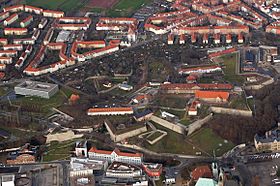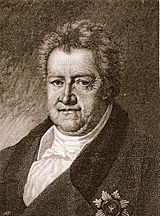Capitulation of Erfurt facts for kids
Quick facts for kids Capitulation of Erfurt |
|||||||
|---|---|---|---|---|---|---|---|
| Part of the War of the Fourth Coalition | |||||||
 Petersberg Citadel, Erfurt |
|||||||
|
|||||||
| Belligerents | |||||||
| Commanders and leaders | |||||||
| Strength | |||||||
| 16,000 | 10,000-12,000, 65 guns | ||||||
| Casualties and losses | |||||||
| None | 10,000-12,000, 65 guns | ||||||
The Capitulation of Erfurt happened on October 16, 1806. It was a major event during the Napoleonic Wars, specifically the War of the Fourth Coalition. A large group of soldiers from the Kingdom of Prussia surrendered to Marshal Joachim Murat of France. This took place in the city of Erfurt, which is now in Germany.
The Prussian soldiers were very discouraged. Just two days before, they had suffered a huge defeat at the Battle of Jena–Auerstedt. Because of this, they didn't want to fight much more. When Murat's French cavalry arrived at Erfurt, the city gave up without a fight. Erfurt is located about 40 kilometers west of Jena.
Contents
How the War Started
In early October 1806, Emperor Napoleon I of France led his large army into the Electorate of Saxony. This was part of his plan to defeat the Prussian forces. The French quickly won two smaller battles. These early victories set the stage for a much bigger fight.
Prussian Armies Gather
The Prussian army had three main groups. These were led by Charles William Ferdinand, Duke of Brunswick, Frederick Louis, Prince of Hohenlohe-Ingelfingen, and Ernst von Rüchel. Prince Hohenlohe's army also included 20,000 soldiers from Saxony.
- Duke Brunswick's main army gathered near Erfurt.
- Prince Hohenlohe defended Rudolstadt to the east.
- General Rüchel held Gotha and Eisenach to the west.
Another Prussian group, led by Karl August, Grand Duke of Saxe-Weimar-Eisenach, moved south. They aimed to cut off the French supply lines. A reserve army, led by Eugene Frederick Henry, Duke of Württemberg, was much further north at Magdeburg.
Early French Victories
On October 8, Napoleon's army of 180,000 soldiers crossed into Saxony. They moved in a special formation, like a large square. This formation included different army groups, the French Imperial Guard, and soldiers from Bavaria.
- On October 9, the French won a small battle at Battle of Schleiz.
- The next day, French Marshal Jean Lannes's troops defeated a Prussian division. This happened at the Battle of Saalfeld, where the young Prussian Prince Louis Ferdinand was killed.
The Big Battle of Jena-Auerstedt
On October 12, Napoleon ordered his army to turn west. The Prussian generals decided to retreat. They planned to use the Saale River to protect their side.
- Duke Brunswick marched his main army north from Weimar.
- Prince Hohenlohe stayed near Jena to protect the army's side.
- General Rüchel was ordered to stay at Weimar.
On October 14, two major battles happened at the same time: the Battle of Jena-Auerstedt.
- Napoleon attacked Hohenlohe's forces near Jena.
- Brunswick's army ran into Marshal Louis Davout's French troops near Auerstedt.
The Prussian armies of Brunswick, Hohenlohe, and Rüchel were completely defeated. They were forced to run away. Brunswick's army lost 13,000 men, and he was badly wounded. Hohenlohe and Rüchel lost as many as 25,000 soldiers.
French Pursuit After Victory
After their huge win at Jena, Napoleon quickly gave orders on October 15. He wanted his army to chase the fleeing Prussians.
- Marshal Murat's cavalry was sent in two directions: half went west to Erfurt, and half went northwest to Buttelstedt.
- Marshal Michel Ney's troops followed Murat to Erfurt.
- Marshal Nicolas Soult's troops went to Buttelstedt.
- Marshal Jean-Baptiste Bernadotte's fresh troops marched north to prevent Prussians from escaping across the Elbe River.
- Other French armies, like those of Marshal Jean Lannes and Marshal Pierre Augereau, rested near Weimar.
The Surrender at Erfurt
After the battles on October 14, many Prussian soldiers who had run away arrived at Erfurt. At first, the city gates were closed to them. But later, the gates opened, and soon about 12,000 tired and defeated soldiers filled the city. Some officers tried to get the soldiers back into their units, but the men refused.
By noon on October 15, Marshal Murat and his cavalry were close to Erfurt. A Prussian general, von Jung-Larisch, tried to set up a defense outside the city. But his position was bad, with the Gera River behind him. He ordered his soldiers to go back inside the city. Murat's cavalry charged, pushing Jung-Larisch's horsemen back across the river. They also captured some Prussian cannons.
The Duke of Saxe-Weimar's division, which had missed the big battle, arrived west of Erfurt. Feldmarschall Wichard Joachim Heinrich von Möllendorf tried to organize an orderly retreat from Erfurt. He wanted to move the troops northwest to Bad Langensalza. He told Saxe-Weimar to protect this movement. The plan was for the supply wagons to go first, then the cavalry, and finally the infantry. However, Möllendorf, who had been wounded, became too ill to lead the retreat.
At 2:30 PM, Murat sent a French officer into Erfurt to demand surrender. The Prussian commander of the fortress at first said no. Saxe-Weimar waited near Erfurt, hoping more soldiers would join his retreat. But very few did. That evening, Saxe-Weimar pulled his troops back towards Langensalza. He now had about 12,000 soldiers and 24 cannons.
With Möllendorf unable to lead, the fortress commander's will to fight weakened. That night, he signed the surrender papers. This meant the Petersberg fortress and large amounts of gunpowder and weapons were given to the French.
About 12,000 Prussian and Saxon soldiers, led by the Prince of Orange, became prisoners. The French also captured 65 cannons. Many flags from different Prussian army units were also taken by the French. Some reports say between 9,000 and 14,000 Prussian soldiers were captured. This number might include up to 8,000 wounded soldiers. At the time of the surrender, Murat had about 16,000 French troops near Erfurt.
Prisoners Escape
As the first group of prisoners was being marched from Erfurt to Frankfort-on-the-Main, something unexpected happened. About 50 Prussian hussar (cavalry) soldiers attacked the small French guard. They scattered the guards and freed between 4,000 and 5,000 prisoners. Napoleon was very angry when he heard about this. However, the Duke of Saxe-Weimar couldn't use this chance to help the Prussians. He tried to gather the freed prisoners, but they all ran away and couldn't be brought back to their units.
What Happened Next
The surrender of Erfurt was very important for Napoleon. It allowed him to change his army's supply route. He could now use a more direct path through cities like Frankfort-on-the-Main, Eisenach, Gotha, and Erfurt. This made it easier to supply his army.
After the surrender, Murat continued to chase the Prussians. He advanced to Langensalza, but Saxe-Weimar managed to escape. Other French cavalry divisions continued to pursue the Prussians further east.
The Battle of Halle happened on October 17. In this battle, Marshal Bernadotte's French troops fought Duke Eugene of Württemberg's Prussian Reserve army. The French caused 5,000 casualties to the Prussians.
Historian Francis Loraine Petre noted that Erfurt was the first of several quick surrenders by Prussian fortress commanders. He believed that if Erfurt had held out for even a few days, Napoleon's plans might have been slowed down. Instead, the French emperor was able to immediately send his entire army after the fleeing Prussian forces.
See also
- Petersberg Citadel
- Principality of Erfurt





